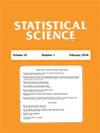Bayesian Adaptive Randomization with Compound Utility Functions
IF 3.9
1区 数学
Q1 STATISTICS & PROBABILITY
引用次数: 1
Abstract
Bayesian adaptive designs formalize the use of previous knowledge at the planning stage of an experiment, permitting recursive updating of the prior information. They often make use of utility functions, while also allowing for randomization. We review frequentist and Bayesian adaptive design methods and show that some of the frequentist adaptive design methodology can also be employed in a Bayesian context. We use compound utility functions for the Bayesian designs, that are a trade-off between an optimal design information criterion, that represents the acquisition of scientific knowledge, and some ethical or utilitarian gain. We focus on binary response models on two groups with independent Beta prior distributions on the success probabilities. The treatment allocation is shown to converge to the allocation that produces the maximum utility. Special cases are the Bayesian Randomized (simply) Adaptive Compound (BRAC) design, an extension of the frequentist Sequential Maximum Likelihood (SML) design and the Bayesian Randomized (doubly) Adaptive Compound Efficient (BRACE) design, a generalization of the Efficient Randomized Adaptive DEsign (ERADE). Numerical simulation studies compare BRAC with BRACE when D-optimality is the information criterion chosen. In analogy with the frequentist theory, the BRACE-D design appears more efficient than the BRAC-D design.具有复合效用函数的贝叶斯自适应随机化
贝叶斯自适应设计在实验的规划阶段将先前知识的使用形式化,允许对先前信息进行递归更新。它们通常使用效用函数,同时也允许随机化。我们回顾了频率论和贝叶斯自适应设计方法,并表明一些频率论自适应设计方法也可以应用于贝叶斯环境。我们在贝叶斯设计中使用复合效用函数,这是代表获得科学知识的最佳设计信息标准与一些道德或功利收益之间的权衡。我们关注的是成功概率具有独立Beta先验分布的两组的二元响应模型。处理分配将收敛于产生最大效用的分配。特殊情况是贝叶斯随机(简单)自适应复合(BRAC)设计,它是频率序列最大似然(SML)设计的扩展,贝叶斯随机(双重)自适应复合高效(BRACE)设计,是高效随机自适应设计(ERADE)的推广。数值模拟研究了选择d -最优信息准则时BRAC与BRACE的比较。与频率理论类比,BRACE-D设计似乎比BRAC-D设计更有效。
本文章由计算机程序翻译,如有差异,请以英文原文为准。
求助全文
约1分钟内获得全文
求助全文
来源期刊

Statistical Science
数学-统计学与概率论
CiteScore
6.50
自引率
1.80%
发文量
40
审稿时长
>12 weeks
期刊介绍:
The central purpose of Statistical Science is to convey the richness, breadth and unity of the field by presenting the full range of contemporary statistical thought at a moderate technical level, accessible to the wide community of practitioners, researchers and students of statistics and probability.
 求助内容:
求助内容: 应助结果提醒方式:
应助结果提醒方式:


